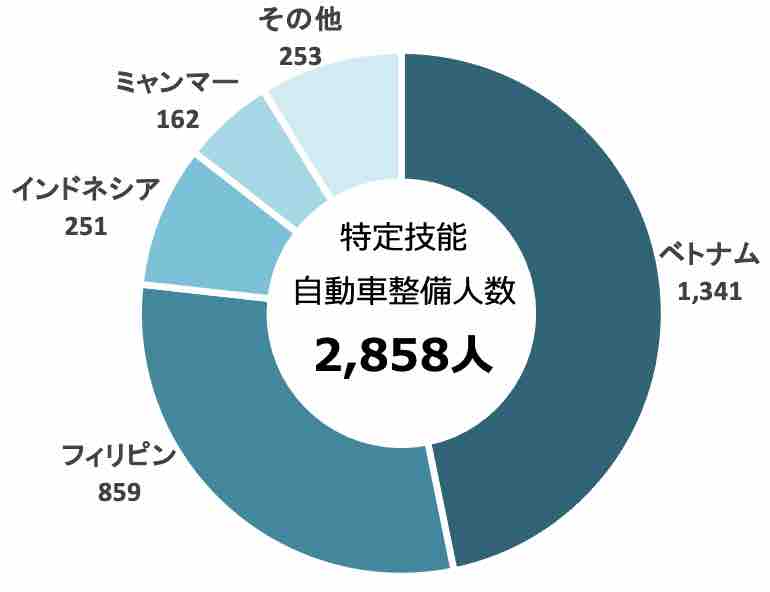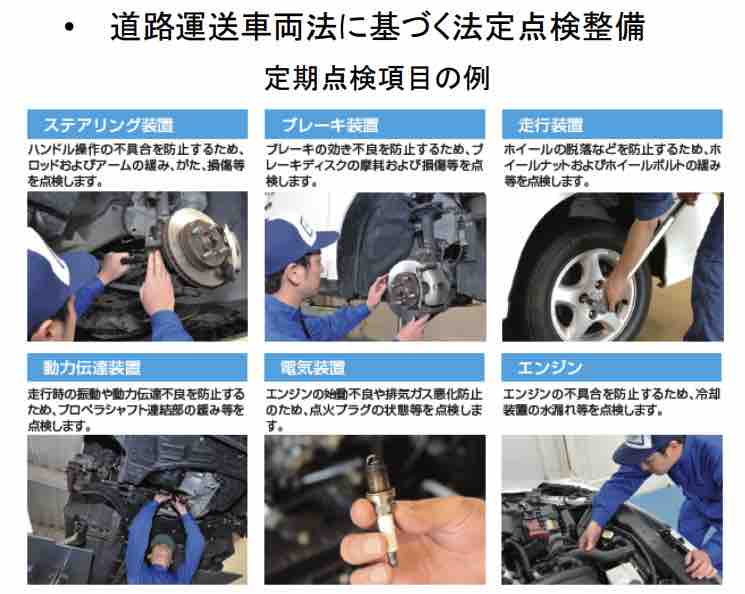Job Introduction - { % trans '自動車整備' %}
This page provides information to help with career choices, such as types of jobs in automotive maintenance, their annual income, current worker numbers, and job descriptions.
Index
- 1. What is SSW in Automotive Maintenance?
- 2. Job details
- 3. Required Exams and Qualifications
1. What is SSW in the Accommodation Industry?
1-1 Background
The automotive maintenance industry is facing a severe labor shortage due to factors such as the declining birthrate, young people moving away from cars, and the diversification of career choices. As the average age of automotive maintenance workers rises, it has become difficult to secure enough domestic talent. In response to this situation, a system was introduced to accept foreign workers.
1-2 Population and Current Status
The Immigration Services Agency aggregates and publishes the number of people working under the SSW qualification every six months (previously every three months until 2022). According to the data, the population ratio by country or age is as follows.

As of the end of June 2024, there are 2,585 people working in the SSW automotive maintenance industry. Most of the workers are from Asia, with Vietnam, the Philippines, Indonesia, and Myanmar being the top countries of origin.

Although the SSW system began in 2019, the population of workers in automotive maintenance has increased approximately 2.5 times over the past three years, and the number is expected to continue expanding.
source : 出入国在留管理庁(https://www.moj.go.jp/isa/applications/ssw/zairyuarchive.html)
There are two systems for accepting foreign workers: the Technical Intern Training Program and the SSW Program, but their purposes and characteristics are quite different.
The Technical Intern Training Program aims to equip young people from developing countries with Japanese technical skills, enabling them to contribute to their home countries' development after returning. The main purpose is skill acquisition, and it is positioned as training rather than labor. Therefore, job changes are not allowed, and the maximum duration is five years.
On the other hand, the SSW Program was established to supplement Japan's labor shortage. There are two types, SSW 1 and SSW 2, which accept foreign workers as immediate assets. Job changes are allowed, and in SSW 2, it is possible to bring family members and even apply for permanent residency. A test to prove skills and Japanese language ability is required, and workers with practical experience are preferred.
In addition, foreign workers who have completed the Technical Intern Training Program can transition to the SSW Program. Experience gained through technical training is recognized, and part of the SSW 1 test is exempted, making the transition relatively smooth. This allows foreign workers to continue working in Japan for a longer period after completing their internships, with opportunities for job changes and career advancement.
2. About Jobs and Duties in the Accommodation Industry
2-1 2-1 Job Description
In the "Automotive Maintenance" SSW, the two main tasks are Periodic Inspection Maintenance and Disassembly Maintenance.
Periodic Inspection Maintenance is legally required in Japan and is conducted regularly. It involves checking if the vehicle's components, such as the engine and brakes, meet standards and performing preventive maintenance to avoid malfunctions. Periodic inspections are mandatory to ensure safe driving and are conducted as part of legal requirements.

Disassembly Maintenance involves disassembling important parts of the vehicle, such as the engine, brakes, and transmission, for repair when malfunctions or defects occur. Mechanics use their skills to repair and return the vehicle to normal condition.

2-2 Average Salary
2-2 Average Salary
The average monthly salary for workers in the "Automotive Maintenance" SSW is ¥249,481, which is slightly higher than the average across all fields, ¥231,979. This amount includes overtime and other allowances, and while it may vary depending on the region and company, overall, it is a stable source of income. Additionally, companies are required to provide social insurance and welfare benefits, ensuring medical and pension support. Furthermore, automotive maintenance is a technical profession, offering opportunities for pay raises as you gain experience. Working in the automotive maintenance sector under SSW offers both skill development and stable income, making it an attractive career choice.
3. Required Exams and Qualifications
To obtain the "Automotive Maintenance" SSW qualification, you must pass both a Japanese language test and a skill test.
3-1 Japanese Language Test
There are two types of Japanese language tests: the Japanese Language Proficiency Test (JLPT) and the Japan Foundation Test for Basic Japanese (JFT-Basic), and you must pass one of them.
The Japanese Language Proficiency Test (JLPT) evaluates the Japanese language ability of non-native speakers. JLPT has five levels (N1, N2, N3, N4, N5), with N1 being the most difficult and N5 being the easiest. To meet the requirements of the SSW test, you must pass N4 or higher. N4 is the level that demonstrates the ability to understand basic Japanese, and it tests whether you can engage in everyday conversations and read simple texts.
- Time: Twice a year (July and December)
- Test Locations: Various countries and regions around the world
- How to Apply: Online or by mail
- Test Method: Mark sheet (on-site)
source : 日本語能力試験 JLPT(https://www.jlpt.jp/index.html)
The Japan Foundation Test for Basic Japanese (JFT-Basic) has six levels (A1, A2, B1, B2, C1, C2), with C2 being the most difficult and A1 being the easiest. To meet the requirements of the SSW test, you must pass A2 or higher. A2 is the level that demonstrates the ability to understand basic Japanese, and it tests whether you can engage in everyday conversations and read simple texts.
- Time: Anytime throughout the year
- Test Locations: Various countries and regions around the world
- How to Apply: Online reservation
- Test Method: CBT (Computer-Based Testing)
source : 国際交流基金日本語基礎テスト JFT-Basic(https://www.jpf.go.jp/jft-basic/)
This site summarizes detailed test structures, sample questions, test information, and strategies for the Japanese Language Proficiency Test (JLPT) and the Japan Foundation Test for Basic Japanese (JFT-Basic).
3-2 3-2 Skill Evaluation Test
The automotive maintenance SSW exam evaluates the basic knowledge and skills needed to work as an automotive mechanic in Japan. The exam is of intermediate difficulty (equivalent to Grade 3 Skills Test). It is conducted by the Japan Automotive Maintenance Promotion Association (JASPA) under the guidance of the Ministry of Land, Infrastructure, Transport, and Tourism. There are both written and practical tests, and those who pass can obtain the SSW qualification and work legally in Japan.
- Time: Anytime throughout the year
- Test Locations: Various countries and regions around the world
- How to Apply: Online reservation
- Test Method: CBT (Computer-Based Testing)
This site summarizes detailed test structures, sample questions, test information, and strategies for the automotive maintenance SSW exam.